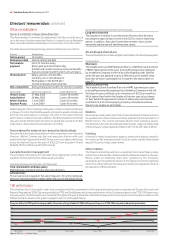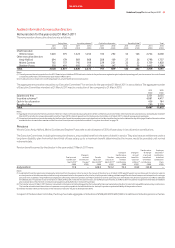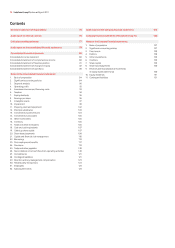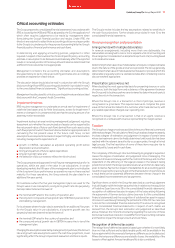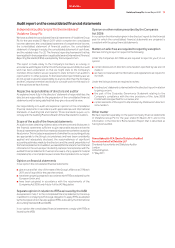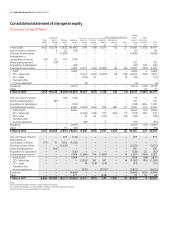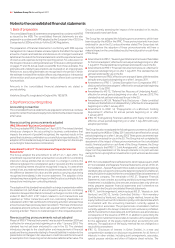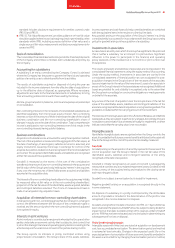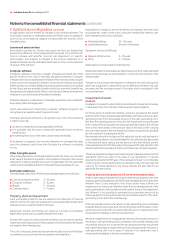Vodafone 2011 Annual Report Download - page 79
Download and view the complete annual report
Please find page 79 of the 2011 Vodafone annual report below. You can navigate through the pages in the report by either clicking on the pages listed below, or by using the keyword search tool below to find specific information within the annual report.
Vodafone Group Plc Annual Report 2011 77
Financials
The Group prepares its consolidated financial statements in accordance with
IFRS as issued by the IASB and IFRS as adopted by the EU, the application of
which often requires judgements to be made by management when
formulating the Group’s financial position and results. Under IFRS, the
directors are required to adopt those accounting policies most appropriate
to the Group’s circumstances for the purpose of presenting fairly the Group’s
financial position, financial performance and cash flows.
In determining and applying accounting policies, judgement is often
required in respect of items where the choice of specific policy, accounting
estimate or assumption to be followed could materially affect the reported
results or net asset position of the Group should it later be determined that
a different choice would be more appropriate.
Management considers the accounting estimates and assumptions
discussed below to be its critical accounting estimates and, accordingly,
provides an explanation of each below.
The discussion below should also be read in conjunction with the Group’s
disclosure of significant IFRS accounting policies which is provided in note 2
to the consolidated financial statements, “Significant accounting policies”.
Management has discussed its critical accounting estimates and associated
disclosures with the Company’s Audit Committee.
Impairment reviews
IFRS requires management to undertake an annual test for impairment of
indefinite lived assets and, for finite lived assets, to test for impairment if
events or changes in circumstances indicate that the carrying amount of an
asset may not be recoverable.
Impairment testing is an area involving management judgement, requiring
assessment as to whether the carrying value of assets can be supported by
the net present value of future cash flows derived from such assets using
cash flow projections which have been discounted at an appropriate rate. In
calculating the net present value of the future cash flows, certain
assumptions are required to be made in respect of highly uncertain matters
including management’s expectations of:
■growth in EBITDA, calculated as adjusted operating profit before
depreciation and amortisation;
■timing and quantum of future capital expenditure;
■long-term growth rates; and
■the selection of discount rates to reflect the risks involved.
The Group prepares and approves formal five year management plans for its
operations, which are used in the value in use calculations. In certain
developing markets the fifth year of the management plan is not indicative
of the long-term future performance as operations may not have reached
maturity. For these operations, the Group extends the plan data for an
additional five year period.
For businesses where the five year management plans are used for the
Group’s value in use calculations, a long-term growth rate into perpetuity
has been determined as the lower of:
■the nominal GDP rates for the country of operation; and
■the long-term compound annual growth rate in EBITDA in years six to ten
estimated by management.
For businesses where the plan data is extended for an additional five years
for the Group’s value in use calculations, a long-term growth rate into
perpetuity has been determined as the lower of:
■the nominal GDP rates for the country of operation; and
■the compound annual growth rate in EBITDA in years nine to ten of the
management plan.
Changing the assumptions selected by management, in particular, the discount
rate and growth rate assumptions used in the cash flow projections, could
significantly affect the Group’s impairment evaluation and hence results.
The Group’s review includes the key assumptions related to sensitivity in
the cash flow projections. Further details are provided in note 10 to the
consolidated financial statements.
Revenue recognition and presentation
Arrangements with multiple deliverables
In revenue arrangements including more than one deliverable, the
deliverables are assigned to one or more separate units of accounting and
the arrangement consideration is allocated to each unit of accounting based
on its relative fair value.
Determining the fair value of each deliverable can require complex estimates
due to the nature of the goods and services provided. The Group generally
determines the fair value of individual elements based on prices at which the
deliverable is regularly sold on a standalone basis after considering volume
discounts where appropriate.
Presentation: gross versus net
When deciding the most appropriate basis for presenting revenue or costs
of revenue, both the legal form and substance of the agreement between
the Group and its business partners are reviewed to determine each party’s
respective role in the transaction.
Where the Group’s role in a transaction is that of principal, revenue is
recognised on a gross basis. This requires revenue to comprise the gross
value of the transaction billed to the customer, after trade discounts, with
any related expenditure charged as an operating cost.
Where the Group’s role in a transaction is that of an agent, revenue is
recognised on a net basis with revenue representing the margin earned.
Taxation
The Group’s tax charge on ordinary activities is the sum of the total current and
deferred tax charges. The calculation of the Group’s total tax charge necessarily
involves a degree of estimation and judgement in respect of certain items
whose tax treatment cannot be finally determined until resolution has been
reached with the relevant tax authority or, as appropriate, through a formal
legal process. The final resolution of some of these items may give rise to
material profits, losses and/or cash flows.
The complexity of the Group’s structure following its geographic expansion
makes the degree of estimation and judgement more challenging. The
resolution of issues is not always within the control of the Group and it is often
dependent on the efficiency of the legal processes in the relevant taxing
jurisdictions in which the Group operates. Issues can, and often do, take many
years to resolve. Payments in respect of tax liabilities for an accounting period
result from payments on account and on the final resolution of open items. As
a result there can be substantial differences between the tax charge in the
consolidated income statement and tax payments.
Significant items on which the Group has exercised accounting judgement
include litigation with the Indian tax authorities in relation to the acquisition
of Vodafone Essar (see note 28 to the consolidated financial statements),
recognition of a deferred tax asset in respect of the losses arising following
the agreement of German tax loss claims (see note 6 of the consolidated
financial statements) and the recognition of a deferred tax asset in respect
of losses in Luxembourg following the settlement of the CFC tax case (see
note 6 to the consolidated financial statements). The amounts recognised
in the consolidated financial statements in respect of each matter are
derived from the Group’s best estimation and judgement as described
above. However, the inherent uncertainty regarding the outcome of these
items means eventual resolution could differ from the accounting estimates
and therefore impact the Group’s results and cash flows.
Recognition of deferred tax assets
The recognition of deferred tax assets is based upon whether it is more likely
than not that sufficient and suitable taxable profits will be available in the
future against which the reversal of temporary differences can be deducted.
Where the temporary differences are related to losses, the availability of the
losses to offset against forecast taxable profits is also considered.
Critical accounting estimates



